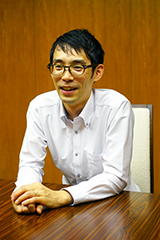Interview with Senior Research Fellow Ishizuka Fumiaki: Considering Asia’s Aging Population by Analyzing Data on Individuals and Households
2021.11.22
What role can the analysis of data on individuals and households play in addressing the issue of Asia’s increasingly aging population? Together with the Asian Development Bank (ADB) and Asian Development Bank Institute (ADBI), the JICA Ogata Sadako Research Institute for Peace and Development (JICA Ogata Research Institute) held an Asia region conference to address this question. Senior Research Fellow Ishizuka Fumiaki who helped organize the conference shared his thoughts on the discussion in the conference.

—What was the conference all about?
The ADB, ADBI, and JICA Ogata Research Institute jointly organized the "Regional Conference on the Health and Socioeconomic Well-Being of Older Persons in Developing Asia: Role of Individual and Household Data," held from Sep. 7 through 9, 2021. While aging population is a social issue in Japan, it is also becoming a pressing concern in many other Asian countries. In Thailand and Vietnam, the populations are forecasted to age at an even faster pace than in Japan. Many countries are facing the same challenging problems, from pensions and safety nets to diminishing labor forces and how to arrange their medical and caregiving systems.
Just as the conference’s subtitle “Role of Individual and Household Data” would indicate, recently there have been many efforts in the world of economics to shed light on causal relationships of various phenomena through the analysis of individual and household data. The field of aging populations is no different, as objective evidence through data analysis increasingly makes it possible for academics and policy makers to more specifically discuss this issue in Japan and in western countries, generating more effective policies. Efforts are also under way to harmonize the collected data to be able to compare countries with one another. We have seen a rising awareness of the pressing need to utilize individual and household data in the field of aging populations in Asia as well, which led to this conference.
—What did the discussions at this conference suggest?
In his keynote speech, Professor Axel Börsch-Supan of the Max Planck Institute for Social Law and Social Policy introduced the "International Social Security Project" by the United States National Bureau of Economic Research as an advanced case of individual and household data utilization in the field of aging populations. Utilizing individual and household data from Japan, the US, and ten countries in Europe, this project has produced numerous findings. As one example, he pointed out how universally the design of pension systems impacts labor participation by the elderly. Through international comparisons such as these, national governments will each have a broader range of policy options at their fingertips. However, he also urged caution that economic, social, and cultural backgrounds can vary even among developed countries, so it is essential to compile objective, high-quality data that remains valid despite such variations. For example, when attempting to obtain information on the health of elderly people, the culture and temperament of the people in any one particular country could cause the responses from that country to be biased when we rely only on subjective answers of the respondents. Therefore, objective data such as body measurements and blood tests must also be collected. I think cases such as these from developed countries will serve as good examples for the Asia region to follow when performing comparative analysis between countries.
(The keynote speech and panel discussion are available for viewing on the ADB website linked below.)
Prior to the conference, the organizers invited submissions of papers that examine issues of aging populations in Asia and many excellent papers were received, 17 of which were presented at the conference. The three papers which I found particularly impressive were as follows.
First was a research paper by Professor Sang-Hyop Lee’s group from the University of Hawaii at Manoa which analyzed health and employment data of elderly people in China and South Korea. They calculated roughly how many elderly people were employable in terms of health, or in other words, not working for one reason or another despite being healthy enough to work. Then, they estimated how much it would contribute to economic growth if all of these elderly people were to work. As a result, they determined that the added employment of these elderly people in China and South Korea would not contribute much additional economic growth relative to other developed countries. This implies that the productivity of elderly people in both countries is relatively low, leading to the suggestion that efforts to improve their productivity such as vocational training might be needed. Additionally, they found that while wealthy elderly people in China’s urban areas retire rather early, elderly people in the country’s rural areas tend to continue working as long as their health allows, regardless of whether or not they are receiving pension. In light of this, they suggested that it would be important to correct the gaps in the pension system between cities and rural areas and to provide a better safety net. Concerning the issue of how to curb the decline of the labor force as society ages, I thought this paper clearly showed how the same remedies from other developed countries might not be effective in Asia. You could surmise that the depth and breadth of pension coverage should be improved in Asian countries where the rate of pension system participation is low, while concurrent efforts to improve labor productivity are also needed.

Professor Sang-Hyop Lee of the University of Hawaii at Manoa
The paper by Assistant Professor Jayash Paudel of Boise State University in the US was also quite interesting. He uses individual and household data to examine the effects of cash transfer programs for the elderly in Nepal on their economic activities. Unfortunately, the cash payments from these programs are not leading to asset purchases or food consumption by elderly people, and for women in particular it was found that these payments have the reverse effect of actually causing them to eat less. He also showed that receiving these payments caused household sizes to increase. This hinted that increases in household income due to cash transfer payments to grandparents have led to larger households with the births of more grandchildren, increasing expenses for these grandchildren. To meet the increasing expenses, grandmothers who regularly take care of the grandchildren are themselves eating less. I think it is important to realize from the perspectives of national governments and donors such as JICA, that cash payments to the elderly are not always accomplishing the original policy aims to improve health and nutrition for the elderly, depending on the circumstances. This also reminded me how important the design of these programs can be, which includes taking gender differences into consideration.

Assistant Professor Jayash Paudel of Boise State University
Third was a paper about improving the capacity of local governments in charge of selecting recipients of cash transfer programs in Bangladesh, presented by Professor Atonu Rabbani (University of Dhaka and BRAC James P Grant School of Public Health). The researchers performed a field experiment to determine whether a state-capacity building intervention consisting of a training and provision of data of people in the target group could improve the selection of beneficiaries for the Old Age Allowance, the national social pension scheme in Bangladesh. In other words, the researchers examined whether the intervention improved the ability of local government representatives to select those who are more eligible to receive the benefit. Although the knowledge level of local government representatives on average increased, the research did not find any improvement in selection performance as measured by eligibility and poverty indexes. However, the selected beneficiaries tended to be poorer in terms of land ownership and individual income, particularly for areas where full interventions were in effect. This called for further investigations and suggested how extraordinarily difficult the task of selection is, especially when the selectors need to juggle many different eligibility and priority criteria while facing a high number of applicants with limited resources at their disposals. Further, illegitimate payment of “fees” during the application process can also influence the selection of beneficiaries. Selection of recipients is always an issue with social programs. I think it was extremely beneficial for JICA to realize that to be effective, considerations must also include the systems and budgets of the programs, and factors such as culture and social practices, in addition to improving the capacities of the agencies and administrative staff of the national governments of partner countries.

Professor Atonu Rabbani of the University of Dhaka and BRAC James P Grant School of Public Health
(You can find the abovementioned papers and presentation materials at the following website of ADB.)
—How do you intend to use what you learned at this conference in your own research going forward?
Aging population is a topic that I had not previously been involved with, but I really learned a lot. In the project "Research on Demand Estimation on Infrastructure in Asia" that I am currently working on at the JICA Ogata Research Institute, we are attempting to reveal the mechanisms that determine demand for infrastructure such as hospital buildings and facilities, and to estimate future demand for such infrastructure in the Asia region. Demand for medical infrastructure in Asia is expected to increase year by year, but this is being driven by demographic shifts—in other words, aging populations. Through this conference, I reaffirmed the need to tackle this aging problem. Going forward, I would like to be involved in compiling the results of the above research project and continue to analyze in the field of the mobilization of funds for infrastructure, while following up the issues of aging populations and data analysis at the individual and household levels.

事業事前評価表(地球規模課題対応国際科学技術協力(SATREPS)).国際協力機構 地球環境部 . 防災第一チーム. 1.案件名.国 名: フィリピン共和国.

事業事前評価表(地球規模課題対応国際科学技術協力(SATREPS)).国際協力機構 地球環境部 . 防災第一チーム. 1.案件名.国 名: フィリピン共和国.

事業事前評価表(地球規模課題対応国際科学技術協力(SATREPS)).国際協力機構 地球環境部 . 防災第一チーム. 1.案件名.国 名: フィリピン共和国.

事業事前評価表(地球規模課題対応国際科学技術協力(SATREPS)).国際協力機構 地球環境部 . 防災第一チーム. 1.案件名.国 名: フィリピン共和国.

事業事前評価表(地球規模課題対応国際科学技術協力(SATREPS)).国際協力機構 地球環境部 . 防災第一チーム. 1.案件名.国 名: フィリピン共和国.
scroll